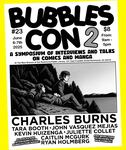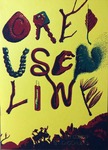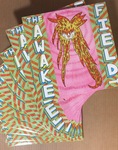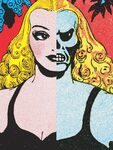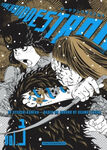COMICS IS
Comics As an Essential American Art Form
Comics, as a mode of expression, as an art form, can be absolutely anything anyone wants it to be. As R. Crumb duly noted, “It’s only lines on paper.” And these lines may make letters and words, signs and symbols, and images of any sort and in any combination that can be conceived. The possibilities are literally endless.
The key to understanding comics, as Scott McCloud would have us do, is to locate the position of comics in our society and the function that arises thereof. Comics, as an American form, has its primary history in being a form of entertainment, occasionally seasoned with education and enlightenment, for the working classes.
The original form of Comics was the newspaper strip. Created during the last decade of the 19th Century to serve as circulation boosters in the struggle for dominance between rival newspaper syndicates, the newspaper strip gradually grew and evolved into an original American art form. It was, however, at this stage, an art form that was not responsible either to or for its audience, but instead was subservient to alien powers: the newspaper syndicates that controlled its existence.
In 1935 comics took on a life of its own with the establishment of the magazine format that came to be known as the comic book. Certainly, the comic book is a commodity form: but it is one that can be considered, at least for the purposes of this essay, as being completely beholden to the work it contains for its economic survival; this holding true despite the fact that many comic books have been nothing more than containers for the hegemonic merchandising of intellectual properties from the dominating mediums of film and television, and, more recently, popular music, computer games, and even trading cards. The comic book is, as Art Spiegelman succinctly, if somewhat crudely, put it, “The bastard child of Art and Commerce.” (While Spiegelman intended this characterization to apply primarily, if not wholly to the newspaper comic strip, it is not difficult to take issue with this aspect of his definition by holding the position that the newspaper comic strip represents the fetal stage of comics’ development and that comics cannot truly be considered an offspring of art and commerce until walking on its own in the comic book.)
While always possessing a special appeal to children due to the directness of presentation, prior to the introduction and enforcement of the Comics Code Authority in 1955 comic books were no more exclusively the province of the young than television is today. A broad range of conventions and traditions from art and literature were incorporated (some, admittedly, more effectively than others) into the comics form at its inception, initiating a process of assimilation, digestion, and synthesis that has continued unabated up to the present day. It was only after the imposition of the Comics Code -- which stated, essentially, that because comic books are especially appealing to children they may contain only material suitable for them -- that the comic book received a definition from without and had its function limited to an ascribed area.
The institution of the Comics Code directly coincided with the ascension of television to the dominant position in the media landscape. Today the comic book is the most marginal form among the commercial mass mediums for the communication of expression that arose during the 20th century and is likely to remain so for as long as it manages to survive. Yet, over the last twenty years or so something of a renaissance has taken place in the world of the comic book as its position at the bottom of the food chain has been perceived as making it ripe for exploitation -- artistic as well as commercial. In 1975 the seeds were planted when a new form of distribution was introduced aimed directly at the core market of comic book aficionados. The growth that this new system led to began flowering in the early 1980’s and has been bearing fruit ever since. 1995, however, was a year in which crisis and consolidation within the infrastructure of the comic book industry provided the revelation that economic growth, driven by an unabashed as well as unrealistic quest for profits, had outstripped the creative growth necessary to sustain it.
At the core of this crisis is the super-hero comic book, a commodity form caught in an inextricable paradox. Its essence being to provide a catharsis for the very alienation its existence is dependent on for survival, that alienation -- which contemporary capital-controlled, profit-driven, corporation-dominated culture imposes on all, but especially upon its structurally marginalized and disfranchised members -- of the individual from his/her ability to decisively direct the course of his/her own life, of the self from its desire, the super-hero comic book must, of necessity, be complicit in maintaining, if not actually creating and nurturing, the same alienation that it purports to alleviate; for the super-hero comic book is primarily a wish-fulfilment fantasy of a life lived without this alienation, of an existence of fully realized unadulterated self-empowerment, devoid of the emotionally crippling frustrations that reality and society ineluctably provide. The problem is, of course, that to allow oneself to become dependent on this fantasy diminishes, to a degree directly proportional to the degree of dependency, the possibilities of achieving any sort of actual self-empowerment. This paradox may be seen as functioning as a synecdoche for the quandary of the American Way -- currently serving as the basis for the "new world order," an order in which empowerment is inextricably rooted in addiction to the sources of American power, specifically advertising driven exploitative capitalism. The illustration of this paradox is central to the work that Chris Ware has been producing since the early 1990s.
Must the comic book be limited to the position of servant to alienation? The answer, obviously, is no. However, to the questions: Can a commodity form do else but replicate and represent the forces that brought it into being? and Is it possible for a commodity form to transcend its origins? the answers must also be no. But a form can be conscious as opposed to ignorant. It can inform rather than delude. And beyond that, a commodity form need not have the drive for profits as its primary motivation, nor have capitalist exploitation at its heart.
It is time to think the unthinkable and recognize the fact that Comics is now a mature form and to treat it as such. It is time to retrench and take stock, to assay the inherent qualities of Comics, to distinguish form from content, and to distill its essence. The time is long overdue to push the boundaries of the place of Comics in the artistic arena, and thereby to expand the capacities of the medium. To these ends an openness to and an increasing interactivity with the other mature and established art forms will be necessary and should be embraced. The establishment, in 2005, of the Center for Cartoon Studies, is a very hopeful sign, indeed.
Comics -- and most particularly and importantly its central and most vital embodiment, the comic book -- is a true American art form, occupying a position in the history of the visual arts that is very much akin to that of Jazz in the history of the musical arts. As a form of artistic expression the comic book is essentially American in a way that no other art form can match. Its contours were shaped by the exigencies of both the American Way and the American Dream. It captures a certain essence of America that falls through the cracks of other forms, that crucial “something” that we all sense went missing-in-action from the artistic discourse at some murky point near the ill-defined border between modernism and post-modernism. It is a fertile ground where image meets text and their respective ontologies and epistemologies can be explored each by the other and the hybrid form of a new mind can emerge from the resultant synthesis.
The objective of The Copacetic Comics Company is to present Comics in its proper context amidst the Arts in America today, both traditional and popular. Towards this end our offerings of comic books, comic strip collections, graphic novels and the like are surrounded by equivalent offerings from Comics' cultural peers: Books of classic and contemporary literature; bound collections of art as well as posters and prints and a light smattering of original art from the region; compact disc recordings of popular and classical music with a special focus on that closest of relatives to Comics, Jazz; digital video discs of culturally significant but under-appreciated and/or under-represented films; and more.
The key distinguishing characteristic of The Copacetic Comics Company is that of editorial discernment. The essential value added to your shopping experience will be our years of accreted knowledge of and insight into the history and workings of Comics; what Comics offers that is unique and what it shares with and draws from other mediums of expression; what was best in its past, what is invigorating its present, and what looks most promising in its future; but more than that, by demonstrating the place of Comics in the cultural sphere, we hope to broaden the horizons of all readers and devotees of the Comics form to embrace and include the vast multiplicity of cultural forms which Comics by their very nature and character interact with at all levels, from the shallowest of superficialities to the deepest of riches, while at the same time draw into the world of Comics those who have only a passing familiarity with it but stand to be pleasantly surprised by what the medium has to offer as a form both of artistic expression and cultural representation, and by these means reinvigorate and replenish the ranks of Comics and further its ends.
Comics, endowed with a formal as well as historical legacy unique among the arts, is singularly well equipped to confront that most American of dilemmas -- the commodification of desire.

